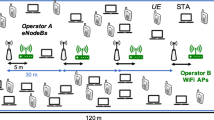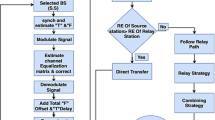Abstract
Providing high capacity wireless networks that are able to support high throughput requirements within the constraint of finite bandwidth resource is crucial and has been the motivation of this work. Received signal quality may vary under different propagation environments due to variation in user location and base station deployment strategy. The investigation and analysis of throughput performance for downlink orthogonal frequency division multiplexing (OFDM) indoor wireless network is presented in this paper. This investigation requires a cross-layer model that takes into account the received signal quality in the physical layer and resource allocation in the medium access control layer. Results have shown that the coverage performance for an indoor wireless network that adopts the aligned configuration (AC) outperforms the offset configuration (OC) by 18% under a low throughput threshold using either maximum rate or equal allocation scheduling. At high throughput threshold, OC outperforms the AC by up to 33% given that MR is used as the scheduling scheme.











Similar content being viewed by others
Notes
Probability mass function is associated with random variables that are discrete unlike probability density function which is associated with continuous random variables.
Relative to the OC.
Extreme SINR here refers to very high and very low SINR values.
Transmission activities of each user arrival is treated individually and has individual user throughput value. Hence, when multiple users arrive at the same location but in different times, this results in multiple throughput values at a particular location.
Consistent coverage refers to the scenario where the percentage area of the floor that meets a particular throughput value does not change significantly as the user distribution varies.
Range is obtained by subtracting the maximum percentage coverage with the minimum percentage coverage for a particular BS configuration and scheduling scheme under varying user distribution.
References
Abu-Dayya, A. A., & Beaulieu, N. C. (1994). Outage probabilities in the presence of correlated lognormal interferers. IEEE Transactions on Vehicular Technology, 43(1), 164–173. https://doi.org/10.1109/25.282277.
Avilés, J. M. R., Toril, M., & Luna-Ramírez, S. (2015). A femtocell location strategy for improving adaptive traffic sharing in heterogeneous LTE networks. EURASIP Journal on Wireless Communications and Networking, 1, 38. https://doi.org/10.1186/s13638-015-0246-0.
Bian, S., Song, J., Sheng, M., Shao, Z., He, J., Zhang, Y., Li, Y., & Chih-Lin, I. (2014). Sum-rate maximization in OFDMA downlink systems: A joint subchannels, power, and MCS allocation approach. In Proceedings of IEEE 25th international symposium on personal, indoor, and mobile radio communication (PIMRC), pp. 1073–1077. https://doi.org/10.1109/PIMRC.2014.7136326.
Butterworth, K. S., Sowerby, K. W., & Williamson, A. G. (2000). Base station placement for in-building mobile communication systems to yield high capacity and efficiency. IEEE Transactions on Communications, 48(4), 658–669. https://doi.org/10.1109/26.843133.
Butterworth, K. S. (2000). Performance, planning and deployment of DS-CDMA in-building wireless communication systems. Ph.D Dissertation, The University of Auckland.
Chao, I. F., & Chiou, C. S. (2013). An enhanced proportional fair scheduling algorithm to maximize QoS traffic in downlink OFDMA systems. In Proceedings of IEEE wireless communications and networking conference, pp 239–243. https://doi.org/10.1109/WCNC.2013.6554570.
Chen, S., Ren, Z., Hu, B., & Ma, W. (2015). Resource allocation in downlink OFDM wireless systems with user rate allowed regions. Wireless Personal Communications, 80(1), 429–445.
Kamal, N. L. M., Sowerby, K. W., & Neve, M. J. (2017). Influence of non-uniform user distribution on throughput performance in outdoor macro-cellular environment. In TENCON 2017–2017 IEEE Region 10 conference, pp. 624–629. https://doi.org/10.1109/TENCON.2017.8227937.
Liu, Z., Sorensen, T. B., & Mogensen, P. E. (2011). Site-specific study of in-building wireless solutions with poisson traffic. In Proceedings of IEEE vehicular technology conference, pp. 1–5. https://doi.org/10.1109/VETECF.2011.6093062.
Mastrosimone, A., & Panno, D. (2017). Moving network based on mmwave technology: A promising solution for 5g vehicular users. Wireless Networks,. https://doi.org/10.1007/s11276-017-1479-0.
Mogensen, P., Na, W., Kovacs, I. Z., Frederiksen, F., Pokhariyal, A., Pedersen, K. I., Kolding, T., Hugl, K., & Kuusela, M. (2007). LTE capacity compared to the shannon bound. In Proceedings of IEEE 65th vehicular technology conference, pp. 1234–1238. https://doi.org/10.1109/VETECS.2007.260.
Namik, S. (2012). Interference modelling and analysis of OFDM in wireless environments. Ph.D Dissertation, The University of Auckland.
Pais, A. V., Sowerby, K. W., & Neve, M. J. (2004). Indoor DS-CDMA system deployment and performance with successive interference cancellation. Electronics Letters, 40(19), 1200–1201. https://doi.org/10.1049/el:20045796.
Perahia, E., Cox, D. C., & Ho, S. (2001). Shadow fading cross correlation between basestations. In Proceedings of IEEE 53rd vehicular technology conference, vol. 1, pp. 313–317. https://doi.org/10.1109/VETECS.2001.944855.
Pujji, L. K., Sowerby, K. W., & Neve, M. J. (2009). A new algorithm for efficient optimisation of base station placement in indoor wireless communication systems. In 2009 Seventh annual communication networks and services research conference, pp. 425–427. https://doi.org/10.1109/CNSR.2009.73.
Rhee, W., & Cioffi, J. M. (2000). Increase in capacity of multiuser OFDM system using dynamic subchannel allocation. In Proceedings of IEEE 51st vehicular technology conference, vol. 2, pp. 1085–1089. https://doi.org/10.1109/VETECS.2000.851292.
Schwartz, M. (2005). Mobile wireless communications. Cambridge: Cambridge University Press.
Shannon, C. E. (1948). A mathematical theory of communication. The Bell System Technical Journal, 27(4), 623–656. https://doi.org/10.1002/j.1538-7305.1948.tb00917.x.
Shen, D., Pan, Z., Wong, K. K., & Li, V. O. K. (2003). Effective throughput: A unified benchmark for pilot-aided OFDM/SDMA wireless communication systems. In Proceedings of IEEE international conference on computer communications, vol. 3, pp. 1603–1613. https://doi.org/10.1109/INFCOM.2003.1209183.
Sowden, B. C. (2009). The performance of DS-CDMA cellular systems with variable-bit-rate traffic. Ph.D Dissertation, The University of Auckland.
Statista. (2017). Global unique mobile subscribers 2010–2020. https://www.statista.com/statistics/371780/unique-mobile-subscribers-worldwide-from-2008/.
Stevens, R. D., & Dilworth, I. J. (1996). Mobile radio shadowing loss variability and co-channel signal correlation at 452 MHz. Electronics Letters, 32(1), 16–17. https://doi.org/10.1049/el:19960055.
Walck, C. (2007). Handbook on statistical distribution for experimentalis. Univ. Stockholm Press.
Wang, X., & Xiang, W. (2006). An OFDM-TDMA/SA MAC protocol with QoS constraints for broadband wireless lans. Wireless Networks, 12(2), 159–170. https://doi.org/10.1007/s11276-005-5263-1.
Wong, J. K. L., Mason, A. J., Neve, M. J., & Sowerby, K. W. (2006). Base station placement in indoor wireless systems using binary integer programming. IEE Proceedings Communications, 153(5), 771–778. https://doi.org/10.1049/ip-com:20050013.
Wong, A. H., Neve, M. J., & Sowerby, K. W. (2007). Antenna selection and deployment strategies for indoor wireless communication systems. IET Communications, 1(4), 732–738. https://doi.org/10.1049/iet-com:20050487.
Yang, Y. H. (2010). Wireless propagation in aged care facilities. Master’s thesis, The University of Auckland.
Zhao, W., & Wang, S. (2014). Joint subchannel and power allocation in multiuser OFDM systems with minimal rate constraints. International Journal of Communication Systems, 27(1), 1–12.
Author information
Authors and Affiliations
Corresponding author
Rights and permissions
About this article
Cite this article
Mohd Kamal, N.L., Sowerby, K.W. & Neve, M.J. On the influence of the propagation environment on throughput performance in indoor wireless network. Wireless Netw 26, 865–878 (2020). https://doi.org/10.1007/s11276-018-1832-y
Published:
Issue Date:
DOI: https://doi.org/10.1007/s11276-018-1832-y




